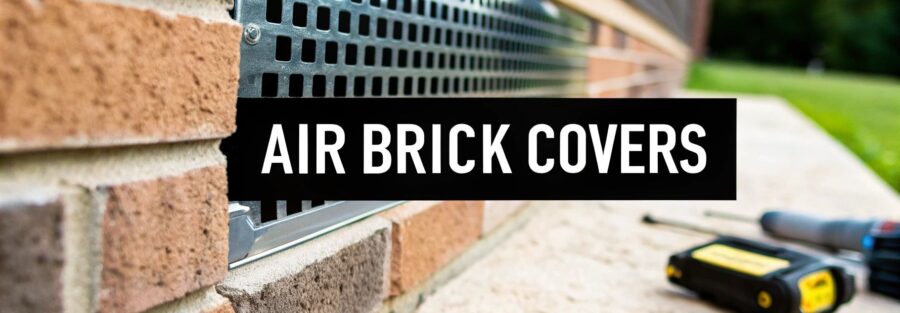Ever noticed those small, vented bricks on the outside of your house? They’re called air bricks, and they’re essential for a healthy home, especially in the damp UK climate. They let air flow under suspended timber floors and inside wall cavities, stopping the moisture build-up that leads to rot and mould.
But here’s the problem: they’re also an open door for pests.
This is where mesh air brick covers come in. They are specialist guards, usually made from tough stainless steel mesh, that fit right over your existing air bricks. The goal is simple: block pests like mice, rats, and insects from getting in, without stopping that crucial airflow.
Why Your Home Needs Mesh Air Brick Covers
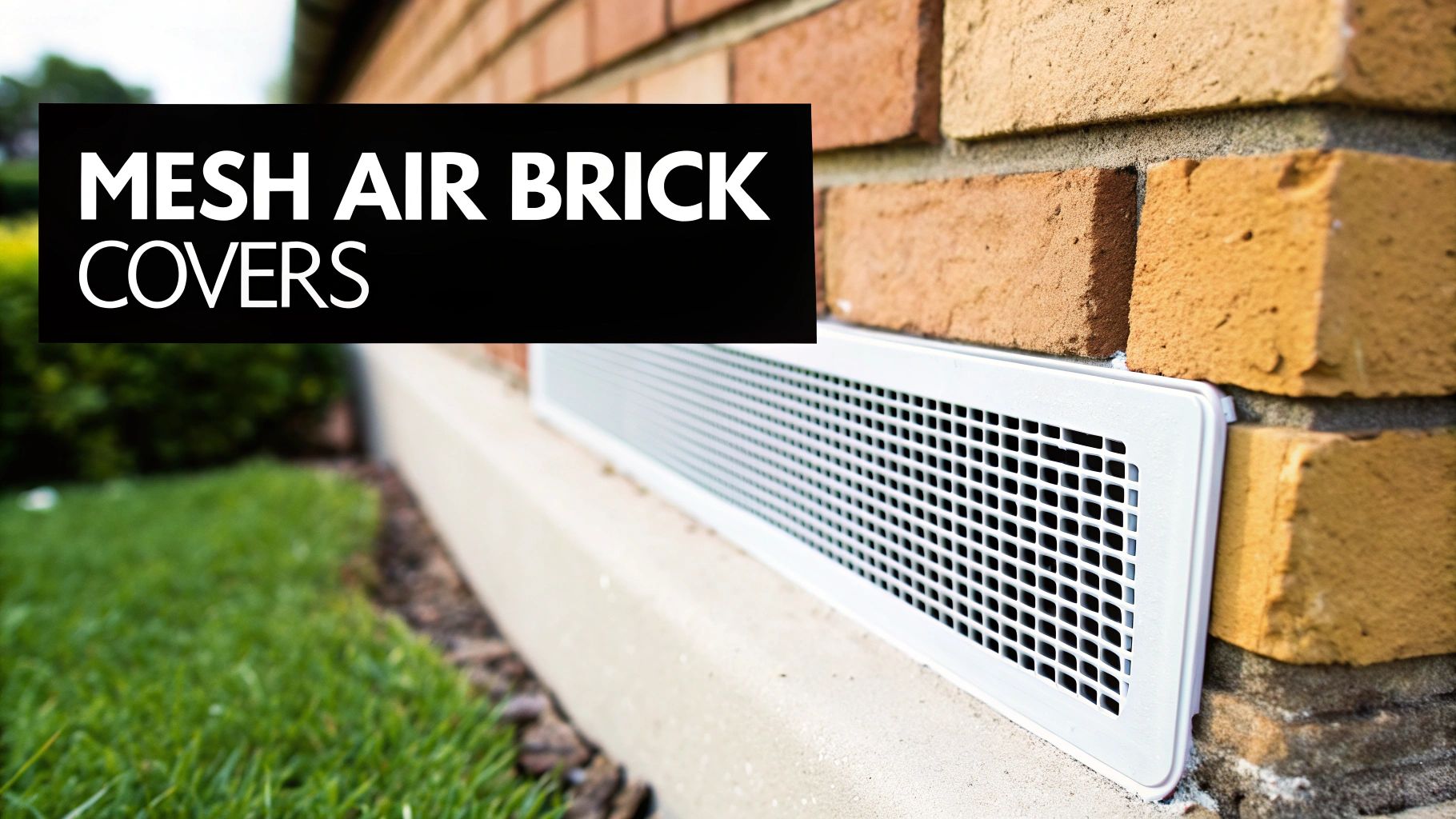
While air bricks are doing their job preventing damp, they create a major vulnerability. An unprotected air brick is essentially a welcome mat for all sorts of unwanted visitors.
The Unseen Gateway For Pests
A mouse can squeeze through a gap the width of a pencil, which makes the holes in a standard air brick an absolute breeze for them to get through. Once they're inside, the real trouble begins. They chew through wiring (a serious fire hazard), contaminate food, and shred your insulation to make nests.
And it’s not just mice. Wasps and bees absolutely love the sheltered, protected space an air brick provides for building a nest. Before you know it, you’ve got a buzzing infestation inside your walls. Spiders and other creepy crawlies also use them as a direct motorway into your home.
The real issue with pests isn't just their presence; it's that traditional methods like traps often only manage the symptoms. The root cause is frequently the unprotected entry points, like air bricks, which allow a constant stream of new pests to enter.
This simple realisation is what drove a lot of the early innovation in professional pest proofing. It became obvious that physically blocking the source was far more effective than constantly dealing with the fallout. The founder of MouseMesh, for instance, developed the product for his own home after getting fed up with conventional pest control methods that just didn't work long-term.
The Perfect Balance of Protection and Airflow
This is why mesh air brick covers are such a smart, permanent fix. They're designed to physically stop pests while letting the air brick do its vital job.
A quality cover delivers on two critical fronts:
- Pest-Proofing: The fine, strong stainless steel mesh is impossible for rodents and larger insects to get through.
- Ventilation: The grid is designed to allow maximum airflow, ensuring your property stays protected from damp and mould.
By fitting these covers, you’re not just dealing with a pest problem after it happens; you’re proactively protecting your home’s structure and your family's health. It’s a small upgrade that delivers huge peace of mind.
To see the difference clearly, let's compare a protected air brick to an unprotected one.
Air Brick Protection Before and After Mesh Covers
The table below breaks down the risks of leaving your air bricks exposed versus the benefits of installing a simple mesh cover.
| Feature | Without Mesh Cover (Unprotected) | With Mesh Cover (Protected) |
|---|---|---|
| Pest Access | Open entry for mice, rats, wasps, and insects. | Entry is completely blocked by a durable steel mesh. |
| Property Risk | High risk of internal property damage and health issues. | Drastically reduced risk of infestations and associated damage. |
| Airflow | 100% airflow, but with full exposure to pests. | Maintained airflow (typically 75-85%) for damp prevention. |
| Peace of Mind | Constant worry about potential pest entry. | Confidence that a key vulnerability has been secured. |
As you can see, installing a mesh cover is a straightforward way to eliminate a significant risk to your property, transforming a weak point into a secure, well-ventilated part of your home's defences.
Choosing the Right Mesh Air Brick Covers
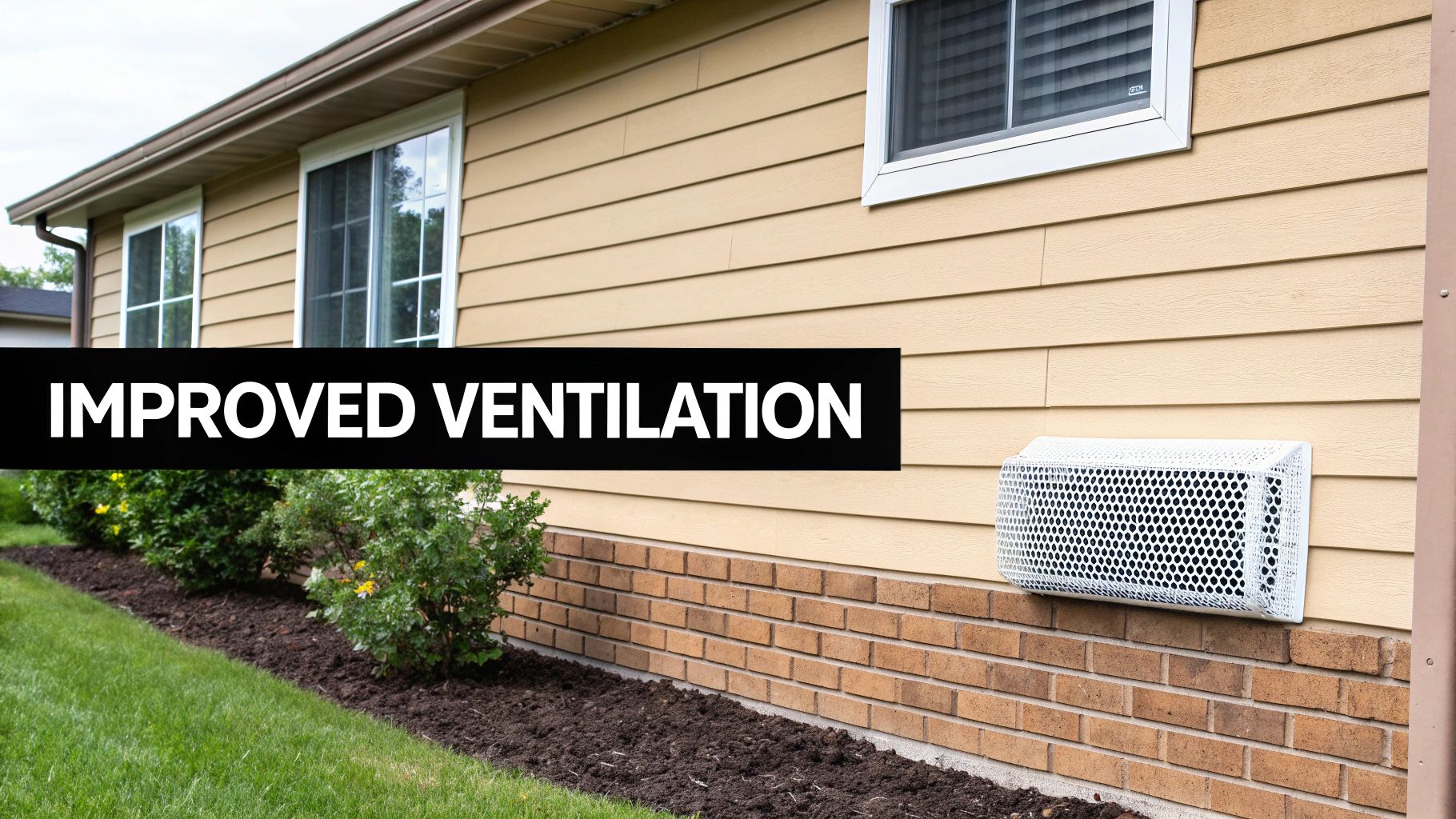
When you start shopping for mesh air brick covers, you'll quickly find out they aren't all created equal. Picking the right one goes beyond just getting the size right; it's about choosing materials that can stand up to both determined pests and the relentless British weather. A flimsy cover might give up the ghost within a year, leaving your home wide open to invaders all over again.
The single most important part is the mesh itself. If you're proofing against rodents, stainless steel mesh is the only real contender. I've seen first-hand how mice and rats can make short work of plastic or even weaker galvanised steel. They are persistent chewers, but a high-quality stainless steel weave creates a tough, impenetrable barrier they just can't breach.
This choice of material is also crucial for longevity. Stainless steel won’t rust or corrode, even after years of being battered by rain and damp. This ensures the cover holds its integrity, giving you reliable, long-term protection that doesn't weaken over time.
Assessing the Frame and Weave
It's not just about the mesh; the frame holding it is just as important. The best covers I've fitted use a frame made from UV-stabilised ABS plastic. This isn't just any old plastic. It's specifically engineered to resist going brittle or yellowing in the sun, which is a must-have feature for anything you fix to the outside of your house. It gives the stainless steel mesh a sturdy, weatherproof home.
The fineness of the mesh weave also matters, depending on what you're trying to keep out.
- For rodents: A standard, strong weave is perfectly fine for blocking rats and mice.
- For insects: If your main headache is wasps, bees, or other insects, you’ll want a finer mesh. This will stop them from getting into your wall cavities to build their nests.
Think about a real-world scenario: a terraced house with a stubborn mouse problem needs that robust, chew-proof stainless steel. On the other hand, a detached home in the countryside might prioritise a finer mesh to stop queen wasps from nesting in spring, while still getting that vital rodent protection.
The goal is to strike a balance between durability and function. A well-made product, with a high-grade stainless steel mesh locked securely into a UV-resistant frame, offers the best value and the most effective defence against all sorts of pests.
Making an Informed Purchase
When you're ready to buy, take a close look at the product’s construction. Does the mesh feel like it’s firmly attached to the frame? A quality cover will have the mesh properly integrated, not just loosely glued in. I've seen poorly made ones where the mesh pops out under pressure from a determined pest, making them completely useless.
By carefully checking the materials and build quality, you can choose a mesh air brick cover that will give you years of effective, worry-free pest prevention. It's a small investment that safeguards your property and brings you total peace of mind.
How to Measure and Fit Your Covers Perfectly
Getting a successful installation isn't just about having the right tools; it all starts with accurate measurements. Taking a few moments to measure correctly means your new mesh air brick covers will fit snugly, look neat, and create a perfect seal against pests. This is especially true for older UK properties where brickwork can be a bit wonky or sizes aren't standard.
First off, grab a reliable tape measure. You need to measure the height and width of the brick opening itself, not just the face of the brick. For instance, a standard UK air brick is typically 215mm x 65mm. But don't just assume that's what you've got. Always measure your specific brick to be certain.
Measure from mortar to mortar to get the exact dimensions of the opening the cover needs to protect. It's also a smart move to measure the full face of the brick as well. This helps you pick a cover with a frame that sits nicely on the brickwork without looking too bulky or too small.
Preparing for a Flawless Fit
Once you've got your measurements and your covers are ready to go, the next step is preparing the surface. This is a simple but crucial part of the process that guarantees a secure, long-lasting fit, whether you're using screws or adhesive.
Start by giving the brickwork a good scrub with a stiff brush. You need to get rid of any loose mortar, dirt, cobwebs, or flaky paint from the area where the cover will sit. A clean, stable surface is absolutely essential for a strong bond. If the brick is damp, make sure to let it dry out completely before you move on.
This quick infographic breaks down the basic flow for installing your covers.
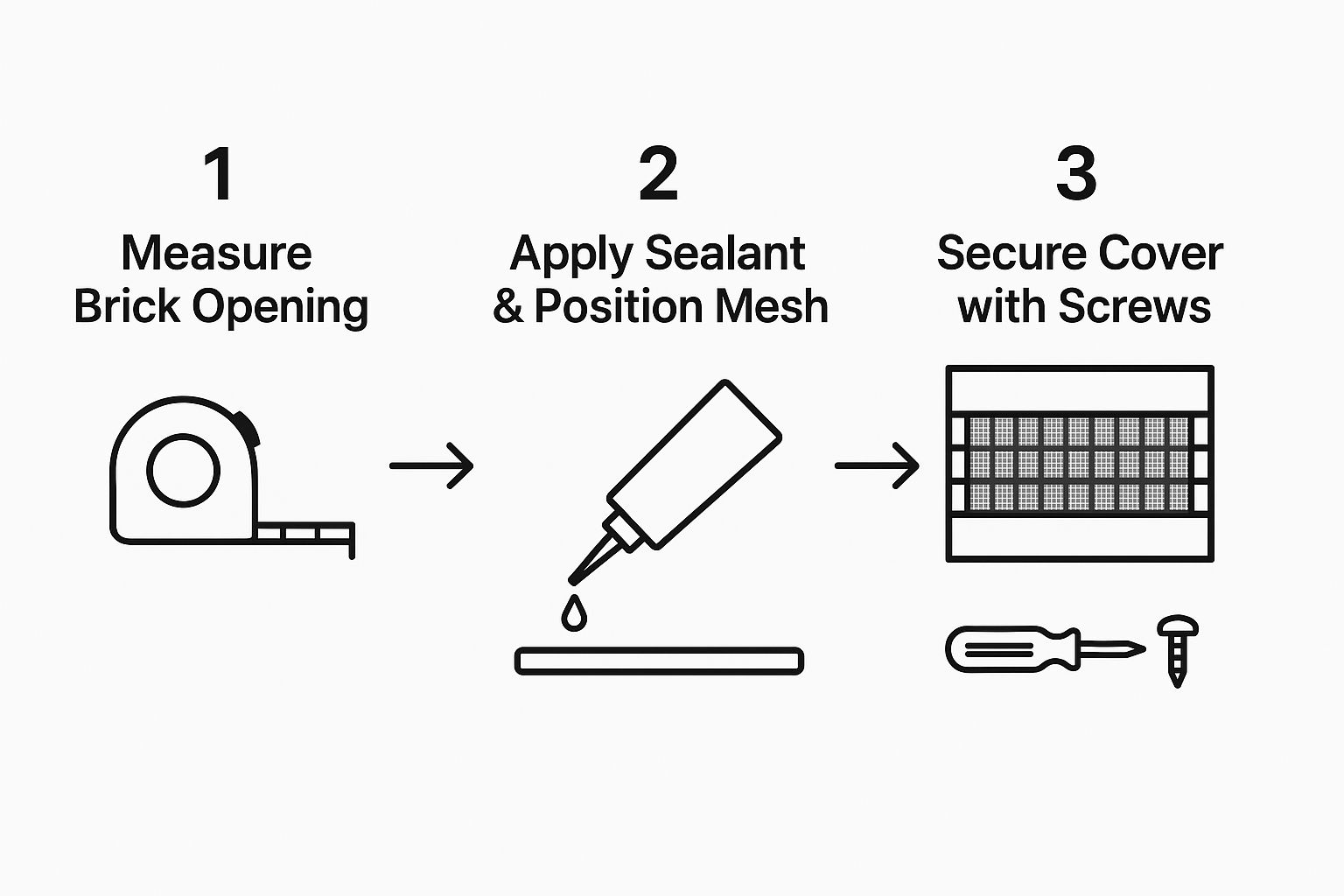
As you can see, it boils down to three core actions, showing just how straightforward the process is from start to finish.
Securing Your Covers: Two Great Options
You've got two excellent choices for fitting your mesh air brick covers, and each has its own benefits.
1. The Screw-Fix Method (Permanent & Robust)
This is the most secure method and my personal recommendation for total peace of mind. It’s rock-solid.
- Hold the cover in place over the air brick and use a pencil to mark the drill points through the pre-drilled holes in the frame.
- Pop the cover aside and drill pilot holes with a masonry drill bit. Be sure to use the correct size for your wall plugs.
- Push the wall plugs into the holes, tapping them in so they're flush with the wall.
- For an extra weatherproof seal, run a thin bead of clear, exterior-grade silicone adhesive around the back of the cover's frame before you position it.
- Line the cover up with the holes and secure it firmly with rust-proof screws. Job done.
2. The Adhesive Method (Less Invasive & Simple)
This is a fantastic choice for listed buildings or if you'd simply rather not drill into your brickwork.
- First, make sure the surface is spotlessly clean and completely dry.
- Apply a generous bead of a high-strength, weatherproof grab adhesive (like CT1 or a similar brand) all the way around the back frame of the mesh cover.
- Carefully press the cover into position, making sure it's level and centred over the air brick.
- Hold it down firmly for a minute or two to ensure the adhesive gets a solid grip. Some people use a bit of masking tape to hold it in place while the adhesive fully cures.
Pro Tip: When you're dealing with uneven brickwork, the adhesive method often gives a much better result. The flexible adhesive fills in any small gaps, creating a more complete and uniform seal against both pests and the weather.
Right, so you've fitted your mesh air brick covers. That’s a brilliant move, but the job isn't quite finished. A little bit of upkeep is all it takes to make sure they keep doing their job perfectly for years to come.
Think of it as a balancing act. These covers need to completely block pests, but they also have to let enough air through to stop damp from building up in your wall cavities or under the floorboards. If you just fit them and forget them, they can get clogged up, and you’ve lost that vital ventilation.
A Quick Seasonal Clean-Up
The good news? Looking after them is dead simple and takes just a few minutes every so often. A quick eyeball is usually enough.
Autumn is the main culprit. When the leaves start to fall, they get wet and can get plastered right up against the mesh, blocking the airflow. You should also keep an eye out for:
- Cobwebs and dust that build up over the months.
- Grass cuttings or dirt blown in by the wind.
- Mud that’s splashed up from heavy rain hitting the ground.
If you see any build-up, cleaning it off is a doddle. Grab a stiff, dry brush and just whisk away any loose bits from the front of the cover. For any muck that's a bit more stubborn, a damp cloth will sort it out. Just don't go at it with harsh chemicals or a pressure washer – you could damage the frame or the mesh itself.
It's worth remembering that this simple check reinforces the cover's dual purpose. It's not just a pest barrier; it's a key part of keeping your home healthy by ensuring air can circulate freely.
Looking at the Bigger Picture
Keeping your mesh covers clear is a small but important part of a much bigger strategy for property care. A clean, effective cover does more than just stop mice; it helps prevent much more expensive headaches down the line.
Across both the UK construction and pest control industries, this is a well-understood principle. High-quality mesh air brick covers are designed to maintain around 75-85% of the original airflow. This is more than enough to meet building regulations for ventilation while still creating a barrier that no pest can get through. We even break down how crucial this is on our TikTok.
Honestly, this small, proactive step is far more cost-effective than waiting for a problem to happen. Dealing with a full-blown rodent infestation or tackling a serious damp and mould issue is stressful, disruptive, and hits the wallet hard. Regular checks on your vents mean that your initial investment keeps paying off, giving you both protection and peace of mind. For a deeper dive into effective strategies, check out our guide on UK pest control services.
By adding these quick checks to your routine, you can be sure your home stays healthy, properly ventilated, and secure from any unwanted visitors.
The Proof Is in the Proofing: Real-World Scenarios
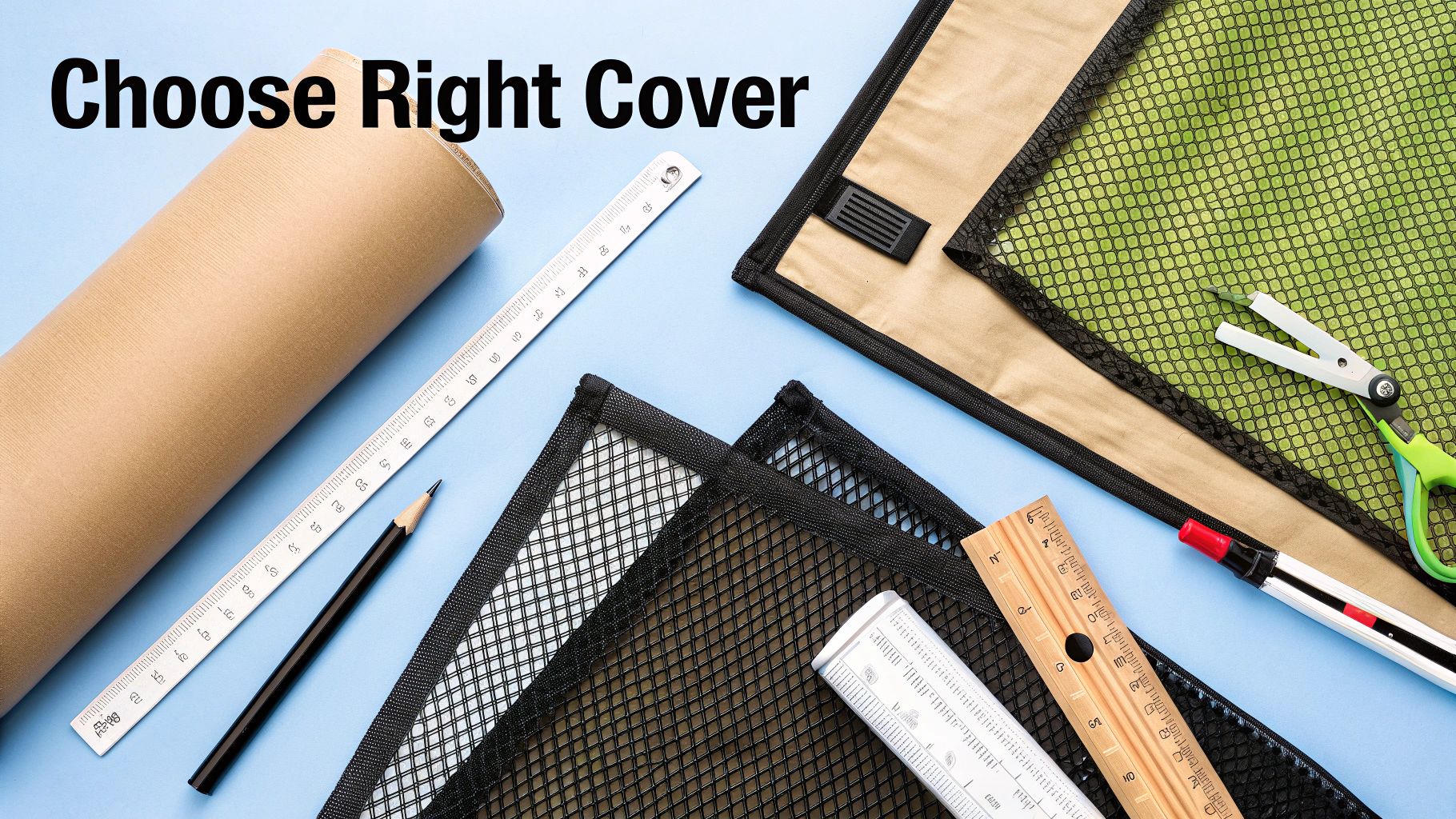
It’s one thing to talk about the theory behind mesh air brick covers, but where do they really show their value? I’ve seen it time and again in homes all over the UK, where these simple devices have finally put a stop to persistent pest problems.
Think about the classic Victorian terrace. These beautiful old houses are notorious for mouse issues. Homeowners often tell me they’ve tried everything—traps, bait boxes, poisons—but every winter, the mice come back. That's because those methods only deal with the pests already inside; they do absolutely nothing to block the source. An open air brick is a permanent "vacancy" sign for the next rodent looking for a warm place to stay.
From Frustration to a Final Fix
Now, let's picture that same house after fitting high-quality mesh covers over the air bricks. Suddenly, that frustrating, recurring cycle is broken. As pest controllers, we often find that once these entry points are properly sealed, the problem is solved for good. The mice simply can’t get in anymore. It turns a reactive, never-ending battle into a proactive, one-and-done fix.
This isn’t just based on my experience; the data tells the same story. Statistics from UK pest control suppliers reveal a clear pattern: older properties like semi-detached and terraced homes with uncovered air bricks can face rodent infestations at rates up to 25% higher than proofed properties. Properly fitted covers have been shown to be over 90% effective at stopping mice from getting in.
The real magic of mesh covers is their simplicity. They tackle the root cause of the infestation—the entry point—rather than just chasing the symptoms. It’s the difference between constantly bailing water out of a leaky boat and just plugging the hole.
Detached Homes and Rural Risks
This principle isn’t just for terraced houses. Different homes face different challenges, and the solution still holds true. Take a detached home that backs onto open fields or farmland. Come late summer and autumn, field mice are actively looking for shelter from the cold, and your house is the perfect target.
For these homeowners, unprotected air bricks aren't just a minor weak spot; they are a guaranteed invitation for seasonal invaders.
By installing robust mesh covers, you create an immediate and highly effective barrier. It transforms a vulnerable property into a fortress against these specific seasonal threats. The investment pays for itself quickly, not just in the money saved on call-outs, but in pure peace of mind. By focusing on comprehensive rodent control proofing, homeowners can secure their properties against all common entry points, and believe me, air bricks are always at the top of that list.
When you shift from temporary fixes to a permanent proofing solution, you’re not just managing a pest problem—you’re eliminating it. The dramatic drop in pest-related call-outs and damage costs for protected homes is all the evidence you need to know this is a truly worthwhile investment.
Your Questions Answered
It's only natural to have a few questions before fitting something new to your home, even a simple solution like mesh air brick covers. Getting straight answers is the best way to feel confident you’re making the right choice.
We get asked these all the time by homeowners across the UK, so we’ve put together the practical information you need.
Will Mesh Covers Cause Damp Problems?
This is easily the most important question, and the short answer is no, as long as you use a quality product. Professionally designed mesh air brick covers are specifically engineered to maintain excellent airflow while keeping pests out.
A good quality cover uses a mesh that allows 75-85% of the original airflow. That's more than enough to meet UK building regulations for sub-floor ventilation and stop damp from becoming an issue. The only thing you need to do is keep the mesh clear of leaves and dirt.
Can I Install These Covers Myself?
Absolutely. If you're comfortable with a bit of basic DIY, fitting these covers is a very straightforward job. Most are designed for an easy fix, either with pre-drilled holes for screws or by using a strong, weatherproof adhesive.
It's a simple process:
- Clean the Brick: First, give the brickwork a good scrub to get rid of any loose dirt or flaky paint.
- Mark Your Holes: If you're using screws, hold the cover in place and mark where you need to drill.
- Fix It On: Either use screws with wall plugs or apply a strong grab adhesive to the back of the frame and press it firmly against the wall.
If your air bricks are in awkward, hard-to-reach spots, or you’d just rather leave it to someone else, any local handyperson can get this sorted for you in no time.
Are They Effective Against All Pests?
Yes, they're brilliant at stopping the most common and destructive pests that try to get into UK homes. Their main job is to form a physical barrier against rodents like mice and rats, which simply cannot get through the tough stainless steel.
But it’s not just about rodents. The fine mesh is also a fantastic defence against insects. It’s particularly good at stopping wasps and bees from building nests inside your wall cavities – a problem that can be a real headache to sort out.
While they won't stop microscopic insects, they solve the primary issue of larger pests using your air bricks as a superhighway into your home. If you think you might already have an unwanted guest, it's always best to look into professional pest control services to deal with the problem before you seal up the entry points.
The best combination for our British climate is a stainless steel mesh inside a durable, UV-stabilised plastic frame. This pairing makes the cover chew-proof, rust-proof, and stops it from going brittle in the sun or frost.
What Is the Best Material to Choose?
For UK homes, you really want a product made from stainless steel mesh set within a weatherproof plastic frame, like ABS. The stainless steel is crucial because it’s strong enough to stop rodents from chewing through and, just as importantly, it won’t rust in our damp weather.
A UV-stabilised plastic frame is just as vital, as it prevents the cover from becoming brittle or discoloured after years of exposure to sun and rain. It's best to steer clear of cheap, flimsy plastic or simple galvanised steel meshes – they often fail or rust, leaving your home vulnerable all over again.
Ready to permanently secure your home from pests? The expert team at Pest Predators Limited offers professional pest-proofing solutions, including the installation of high-quality mesh air brick covers. Safeguard your property today.
Article created using Outrank

